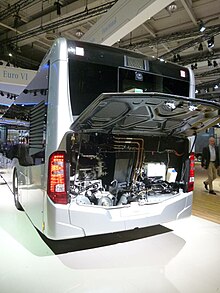Tower motor

As a tower motor or engine tower is used primarily in low-floor - buses colloquially a construction concept, in which the engine is disposed laterally standing together with other drive components and auxiliary equipment such as coolers etc. in a separate compartment of the passenger interior.
As a rule, this engine cabin is located in solo and articulated pusher buses - viewed in the direction of travel - in the left corner of the rear of the vehicle. Manufacturers such as Van Hool also install the engine at the front of their articulated buses, including the VanHool AGG 300 double articulated bus, because the drive is in the front of the vehicle. The cooling system is located on the roof of this vehicle, which means that the engine cabin located on the left in the middle of the vehicle is less voluminous and takes up considerably less space above the lower edge of the window, as the cladding only has to accommodate the cooling water circuit and exhaust system.
In contrast to underfloor motors , a tower motor allows low-floor buses to be designed with stepless entry behind the drive axle and without high platforms or steep ramps in the passenger compartment. Furthermore, the vehicle is easier to maintain than a conventional low-floor bus thanks to the easier accessibility and concentration of the drive components. Only the cardan tunnel behind the axle suspension still has to be built over with a platform construction. Most of the rest of the floor can be lowered.
Another advantage of this motor position is the higher installed radiator, which is much better protected at window height from the dust and dirt that the rear axle in particular stirs up. This makes the cooling system less maintenance-intensive; there is hardly any risk of overheating due to a dirty cooler. The engine block is arranged upright, so that the series engines produced in higher numbers from the truck and aggregate production can be used, which do not need an oil pan lying on the cylinder block. Stationary engines also wear slightly less, as all moving parts such as piston rings and seals in the cylinder housing wear out more evenly.
Disadvantages of the tower motor buses compared to low-floor buses with an underfloor motor are that they do not have three seats and that they generate more noise and heat inside the vehicle. By concentrating all the assemblies on one side, the vehicle is subjected to greater stress there, which must be compensated for by the vehicle's air suspension. Tire and brake pad wear is higher on the engine side. The one-sided weight load also has negative effects on the driving behavior compared to buses with a central engine arrangement. These phenomena also occur in low-floor buses with an underfloor engine, since the drive block is also on the left.
Although the manufacturer Auwärter Neoplan presented a pre-series omnibus with such a tower engine as early as the mid-1980s ( see figure below ), this design has only recently been ready for series production, as the transport companies are increasingly coming under increased cost pressure and are forced to purchase new and the maintenance of vehicles. Low-floor buses with underfloor engines are more complex in terms of construction and maintenance. This concept was only taken up almost twenty years later by foreign bus manufacturers such as Solaris , Scania , Van Hool and Volvo . The German manufacturers EvoBus (with the bus brands of Mercedes-Benz and Setra ) and MAN also adopted this concept later .
Some manufacturers assemble the complete drive block in their buses, consisting of the engine, cooling system, auxiliary units and gearbox on a so-called "cradle" ( English for cradle , but also bearing bracket ). The advantage of this suspension is that the drive block can be removed or replaced in a very short time, so that workshop visits are considerably reduced.
A derivation of the laterally arranged tower motor was the engine block in the rear that was perpendicular to the direction of travel, as was only realized in series in Germany with the Kässbohrer Setra S 300 NC and was not able to establish itself in Germany until recently. Here the last rear bench seat was omitted in favor of the engine housing. French and Italian manufacturers such as Renault , Heuliez and Iveco , who merged their bus division under the Irisbus brand ( Iveco Bus since 2013 ), installed the engines in their low-floor public transport vehicles, mostly perpendicular to the direction of travel. An initial constructive shortcoming of this design was that the drive shaft had to be flanged across the gearbox and these loads in everyday use were initially underestimated, which led to increased damage, especially to the angular gearboxes.
In addition to the tower construction, so-called low-entry buses , which are only partially built with low floors, have become increasingly popular in recent years for cost and maintenance reasons . In trolleybuses , however, tower motors are rare; the less voluminous electric drive can usually be installed under the floor without any problems, as the (considerably smaller) auxiliary motors only drive one generator , which, in contrast to a drive train consisting of gearbox, cardan shaft and drive axle in the vehicle, is relatively free can be placed. The same applies to hybrid buses , whose internal combustion engines are built smaller and therefore also have smaller engine boxes in the passenger compartment. Switching equipment, possible gas tanks and power storage systems are usually housed on the vehicle roof in these vehicles, so that completely different requirements are placed on the design anyway.
Web links
VAG Nürnberg tests Lions City Hybrid - schematic structure of the drive system (accessed on January 14, 2014)

